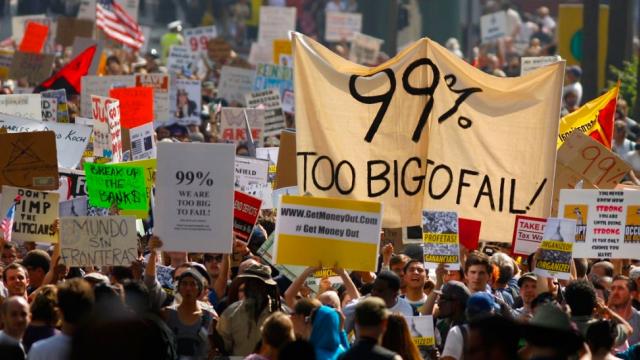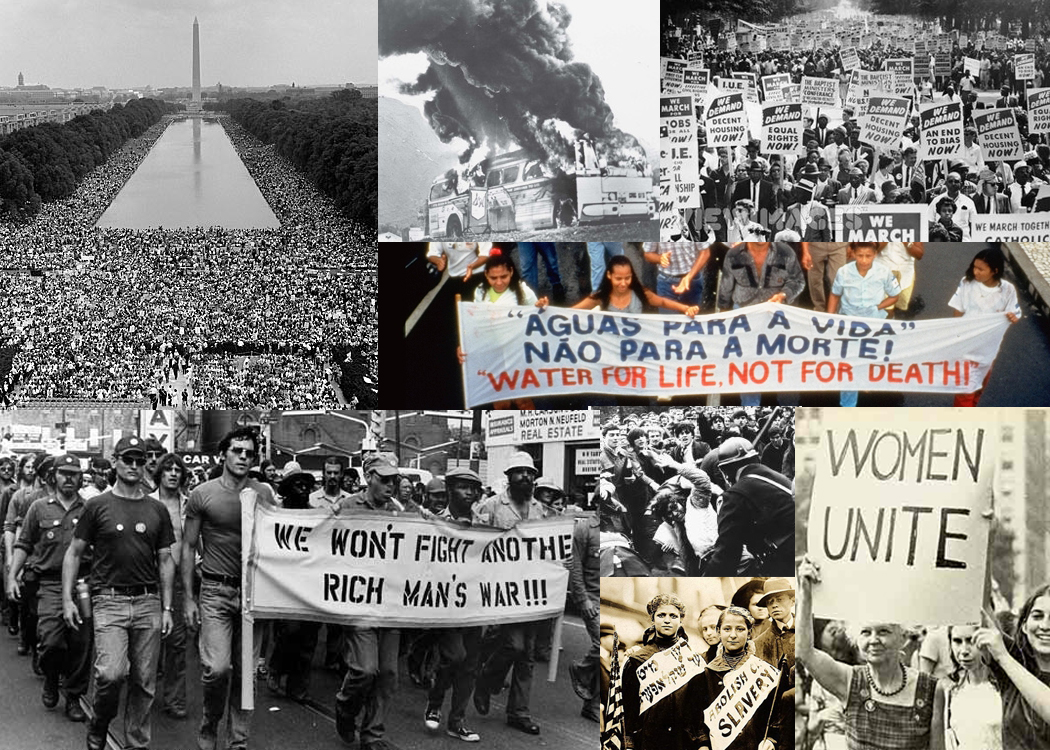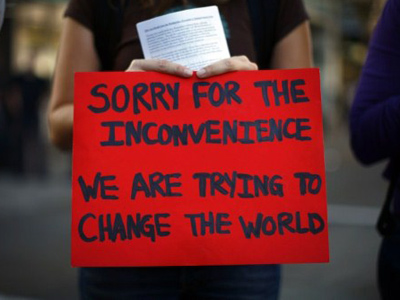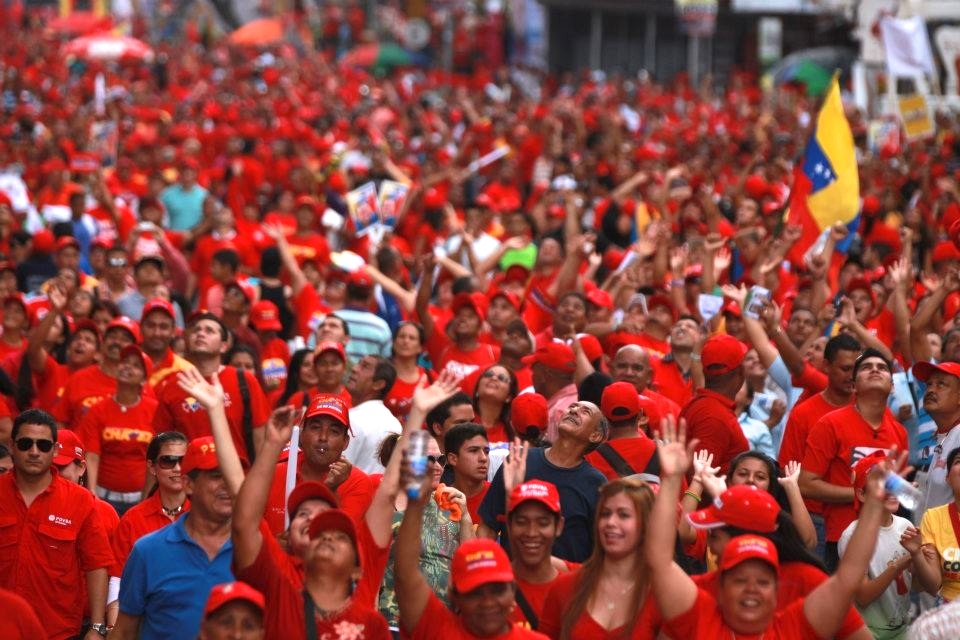
The current social movement that exploded onto the national scene with the 2011 Occupy Movement is following the path of successful movements so far. The social movement in 2014 is poised to begin an exciting era of broadening and deepening the growing consensus for social and economic justice.
Successful people-powered movements follow a similar arc of development. The best description comes from Bill Moyers’sThe Movement Action Plan: A Strategic Framework Describing The Eight Stages of Successful Social Movements. We believe this is essential reading for activists and include a link to it on the strategy page on Popular Resistance.
Moyers expanded this 1987 article into Doing Democracy, a book published in 2001, a year before he died. You can see a video of Bill Moyers’s last public presentation where he summarized the insights of his lifetime about how social movements grow and succeed, and about his vision of a new culture emerging through the cracks of a declining empire.
Moyers’s work is heartening for social justice activists because it shows how movements grow, recede and change their functions at different stages. By understanding the current stage of development we can better define the work that must be done to achieve success and predict how the power structure and public will react to our actions.
Moyers worked with Dr. Martin Luther King, Jr. at the Southern Christian Leadership Conference on poverty campaigns. He also worked on a variety of causes over his nearly 50 year career in social movements.
In a recent conversation, Ken Butigan, a peace and justice activist who worked with Moyers, told us that Moyers wrote the first draft of the Eight Stages of Successful Social Movements when he was jailed with more than 1,400 people protesting the Seabrook Nuclear Power Plant in 1977.
Butigan explained that one reason Moyers wrote the Eight Stages was so people involved in movements would not despair when the movement did not immediately succeed and seemed to disappear without success. These are expected stages of development. Just as we would not expect a 4th grader to be doing calculus, we cannot expect a social movement to jump from Stage 2 to the success of Stage 7. Each step in the process serves an important role.
This Historic Moment
Using the Movement Action Plan as a guide, we see that we are closer to success than one might think. The Occupy Movement was Stage Four of Eight. Moyers describes it:
“New social movements surprise and shock everyone when they burst into the public spotlight on the evening TV news and in newspaper headlines. Overnight, a previously unrecognized social problem becomes a social issue that everyone is talking about. It starts with a highly publicized, shocking incident, a ‘trigger event’, followed by a nonviolent action campaign that includes large rallies and dramatic civil disobedience. Soon these are repeated in local communities around the country.”
Stage 4 is the “Social Movement Take-Off.” During Occupy, it seemed that suddenly the unfair wealth divide, the corruption of Wall Street and the dysfunction of government came into people’s consciousness. These issues were discussed in the media and politicians started using language to show they understood there was a problem. Prior to this, these issues were largely ignored taboo topics that were not on the political radar.
In Stage 4, there are three concepts about which the public must be convinced. The first was accomplished during Occupy, that is: there is a problem that must be confronted. We also began to accomplish the second concept: current conditions and policies must be opposed. During later stages this second goal will be broadened and expanded. The final concept – and this is still ahead of us– is that people no longer fear the alternatives but want the alternatives put in place.
Throughout this process, the movement shows itself to be consistent with the best ideals of the nation, e.g. democracy, equality, justice and fairness; while the movement shows the power structure is out of step with these ideals. The movement exposes the differences between ‘official policies,’ what the government says that it is doing, and ‘actual policies,’ what the policies actually accomplish, which is the opposite of what they claim to accomplish.
Stage 5 is a state of “Identity Crisis and Powerlessness.” Participants feel like they failed and commentators say that the movement is dead and accomplished nothing. Some of the people involved in the Take-Off get burned out and suffer despair and hopelessness. In fact, this is as natural as the receding of a wave and Moyers points out: “The perception of failure happens just when the movement is outrageously successful” because it raised the consciousness and national awareness of a serious problem that was previously ignored.
Moyers quotes the I Ching, “Book of Changes,” an ancient Chinese text which dates back to the 3rd or 2nd millennium BCE, for guidance. The I Ching describes “Retreat” as a time of “an inner conflict based upon the misalignment of your ideals and reality,” i.e. the unrealistic expectation that long-term goals can be achieved immediately. This is a “time to retreat and take a longer look to be able to advance later.” We know many in Occupy who did just that before moving on to Stage 6, where we are now.
During the stage of Identity Crisis or Retreat, activists who step back may realize we actually created a massive grassroots-based social movement, put our issues on the agenda and gained majority support for many of our views. In addition, people began to learn of the enormity of the problem, agonize over the suffering of the victims of the unfair and corrupt economy and realize the complicity of people in power that they trusted.
The essential lesson of Stage 5 is that resistance from the power structure is a normal stage of the process. When we step back and look at the course of history, within the overall framework of change, the movement is on the path to success. We need to understand “what the powerholders already know – that political and societal power ultimately lies with the people.”
Often simultaneous with this feeling of powerlessness is Stage 6, “Majority Public Support,” which is where we are right now. During the current phase, the movement seeks to create broad and deep consensus over the issues that have been raised in the “Take-Off.” Our job is to win over the hearts and minds of the American people.
“The movement must consciously undergo a transformation from spontaneous protest, operating in a short-term crisis, to a long-term popular struggle to achieve positive social change. It needs to win over . . . an increasingly larger majority of the populace and involve many of them in the process of opposition and change. . . The majority stage is a long process of eroding the social, political, and economic supports that enable the powerholders to continue their policies. It is a slow process of social transformation that creates a new social and political consensus, reversing those of normal times.”
During this phase, the movement must transform from a “loose” organizational model to an “empowerment” model. This requires more structure but in order to be effective and create lasting change, it must follow the principles of being “participatory democratic, efficient, flexible, and capable of lasting over the long haul.” The movement must avoid becoming a “professional opposition organization” (i.e. avoid becoming part of the system or a member of the non-profit, professional complex).
The movement must avoid becoming a mainstream group working for “achievable” reforms, focusing on elections and partisanship; instead they must remain “principled dissent groups” advocating for what is right, not what is possible, continuing to protest and resist and be based in the grassroots. Leaders must be “nurturing mothers, not dominant patriarchs.”
The focus at this stage should be grass roots organizing to build a broad-based pluralistic movement. The primary goals are educating, converting, and involving all segments of the population through a variety of means but most importantly through direct contacts at the local level to show people how the big social injustices of our era – the unfair and corrupt economy as well as the dysfunctional and corrupt government – affect them directly. It is important during this phase for the movement to continue to have nonviolent actions, rallies, and campaigns, including civil disobedience at key points of time and key locations – even though the size of protests will be smaller than during the “Take-Off” phase.
In addition to protest, opportunities need to be created for widespread civic involvement in projects that put the people at odds with the current system. These citizen involvement programs need to reflect the movement’s values and goals and the full range of the new world the movement wants to create. The movement should be putting forth a bold vision, a new paradigm, and larger demands beyond mere reforms of the status quo.
Moyers describes a grand strategy that includes 12 phases that lead to Stage 7, “Success.” Throughout this process it is important to remember a movement is only as powerful as its grassroots base and therefore must continue to nourish, support and empower that base. During this phase the movement participants switch roles from being “rebels” to being “change agents.”
The 12 phases are to (1) Keep the issues on the political and social agenda; (2) Win majority support against current policies; (3) Cause powerholders to change strategy although they do not solve problems; (4) Counter each change in strategy by showing it is a gimmick, not a solution; (5) Push powerholders to new strategies that take riskier positions and make it harder to hold old positions; (6) Create strategic campaigns that erode support for the powerholders; (7) Expand policy goals as the movement realizes the problems are greater than was evident; (8) Develop stronger and deeper opposition to current policies; (9) Promote solutions and a paradigm shift; (10) Win majority support for the movement’s solutions; (11) Put the issues on the political and legal agendas; (12) Finally, the powerholders change positions to appear to get in line with public opinion while attacking the movement and its solutions (e.g. passing a Wall Street health law that claims to cover everyone while demonizing single payer health care which would be universal as too extreme).
Opposition to current policies will quickly grow to 60%, then rise to 70% or 75%. Support for the movement’s alternatives will grow more slowly during this time, with the public split on the alternatives. The movement must build public support for the alternatives to achieve success.
At this point, even though everyone wants the issue resolved, the government is still unable to take action. As a movement reaches the end of Stage 6, many powerholders begin to join the calls for change. As elites defect to support majority opinion, the political price paid by those who want to maintain unpopular policies exceeds their benefits and creates a political crisis that leads to resolution.
This leads to Stage 7: “Success.” The duration of Stage 6 is unpredictable and can take years. Success can come in several ways (1) a “dramatic showdown that resembles the ‘take off stage.’” There could be a trigger and the movement needs to mobilize with broad popular support. (2) A “quiet showdown” where the people in power realize they can no longer continue the status quo and launch a face saving endgame of “victorious retreat,” changing their policies and taking credit. (3) Through “attrition” where the social, economic and political machinery slowly evolve to new polices and conditions. The result is not guaranteed when this process begins and the movement must continue the struggle until the goals are won. Stage 8 defends the success and begins the social movement again, focusing on the new injustices of that era.
Applying the Model to the Current Social Movement
In recent years there has been a global awakening of people understanding that big finance capitalism’s neo-liberal model of privatization and corporatization while defunding public programs and cutting necessary services to people is the cause of economic inequality and the failed economy.
At the same time, the collapsing ecology of the planet with mass extinctions, destruction of the oceans and environment as well as the impacts of climate change have become evident to super majorities. The inability of governments to respond appropriately to these crises because they are corrupted by mega-banks and transnational corporate interests has led to mass protests.
A September study of protests from 2006 to mid-2013 found a rapid rise: “Our analysis of 843 protest events reflects a steady increase in the overall number of protests every year, from 2006 (59 protests) to mid-2013 (112 protests events in only half a year).” They found that what is driving protests are four inter-related issues: economic justice and opposition to austerity, failure of political systems, the injustice of global trade rigged for big business, and the rights of people, e.g. indigenous, racial and ethnic groups, workers, women, LGBT, immigrants and prisoners and the right to free speech and assembly.
Another study that mapped protests from 1979 to the summer of 2013 graphically shows the intense increase in protests in recent years. While there were protests against Thatcherism and during the break-up of the Soviet Union as well as against the Iraq War, no period like the last few years has had the intensity and breadth of protests at any time in the last 30 years. It is visually evident in a dramatic, interactive map of protests based on reports in the media (which we know does not even cover most protests).
This research, and so much more, indicates that the global protests have passed Stage 4, the Take-Off phase. In our daily reporting of movement news (sign up for a daily digest of news here) we have identified ten “fronts of struggle” in which sub-movements are very active.
These include (1) mobilizing youth and students and making education a human right, (2) confronting environmental issues around climate change, extreme energy extraction, toxicity, food and mass extinction, (3) creating a national healthcare system based on single payer financing and human rights principles, (4) ending homelessness and creating affordable housing, (5) ending poverty and creating a new democratic economy including confronting the banking and finance system and unfair wages and inadequate employment, (6) ending mass incarceration, police abuse and the drug war, (7) establishing immigrant rights, (8) establishing indigenous sovereignty, and (9) creating a fair global trade system and (10) ending war and militarism. We cover all these fronts on Popular Resistance, and the links above are to weekly newsletters that focused on them or to a series of articles on the issue.
Bill Moyers describes mass movements as being made up of sub-movements. These fronts of struggle combined together in a movement of movements create the foundation of the mass movement on which we will build to broaden and deepen the movement. The uniting theme for these ten sub-movements is a united movement to end the rule of money so the necessities of the people and protection of the planet come before further enriching the wealthiest.
The overarching theme of wealth inequality has already deepened. We see it in the rhetoric of poll-sensitive politicians like President Obama and Mayor-elect de Blasio (whether they do enough about the issue will be in large part dependent on our actions); and we can see it in the criticism of trickle-down economics by Pope Francis. There is no question that the conversation brought to consciousness by Occupy is continuing and deepening.
Economist Dean Baker clarified something that most instinctively understand - inequality is not happening by accident. It is happening because of policy choices made by those in office. This includes trade agreements rigged for transnational corporations, policies favoring big business over small businesses and entrepreneurs, a tax system that protects the wealthiest--especially investors, patent protections for pharmaceuticals that prop up inordinate profits and make healthcare expensive for everyone, continued funding of big banks at a cost of $85 billion a month while not funding a full employment economy or necessary programs like food stamps, raising the budgets of the military and weapons makers while at the same time cutting veterans and government pensions and cutting necessary programs.
Joel Bleifuss of In These Times describes this as a “precarious democracy” where those in office answer to big business, rather than the people. These are policy choices that a well-organized mass movement of people power can change.
Already, the movement is seeing success from its protests, not just in changing the conversation, but in affecting policy.Medea Benjamin points out ten good things that happened in 2013 including stopping the war in Syria, negotiations with Iran, push back on Obama’s drone murders and opposition to the NSA spying program, among other things. While these victories do not constitute our ultimate goals, they show that organized people power is making a difference. They should encourage each of us to increase our efforts to broaden and deepen the movement and to work in solidarity on multiple fronts of struggle.
The Target of Our Efforts Is Mobilizing the People
In the next article we will focus on objectives for 2014 as well as areas where we need to focus our energy and activism. The challenges and opportunities of the upcoming year are important and we can have some important victories.
Bill Moyers, in his final presentation on his Movement Action Plan, makes a crucial point that is often missed by activists. The critical understanding we must embrace is that organized people have the power to direct the government and the economy. We need to understand that we are not a fringe movement, but a movement in the center of the best ideals of the United States.
That is, we believe in a government that is truly run by the people, not by elite corporate and wealthy interests; we believe in equality under the law not special treatment for those who are politically connected and abusive enforcement against certain communities; we believe in a fair economy not one rigged for the wealthiest. This is what the majority of American people believe, but those in power violate these principles.
As we have written in previous articles on strategy to transform the nation, when a movement is able to mobilize a small minority of the population in support of views held by a majority of the people, they win. In fact, a review of the last 100 years of resistance movements found that the people have never lost in a dictatorship or democracy when 3.5% of the people are mobilized.
Bill Moyers sharpens our task, telling us that many activists mistakenly think when they are protesting their target is the government or a corporation when in fact the target is mobilizing the people. We want to show that there is an effective movement speaking to the people’s concerns and putting forth views that they support. This is especially true in the current stage where our task is to broaden and deepen the movement through talking, often one-on one, with people in our communities and creating a national consensus in support of our goals.
3 WAYS TO SHOW YOUR SUPPORT
- Log in to post comments
















